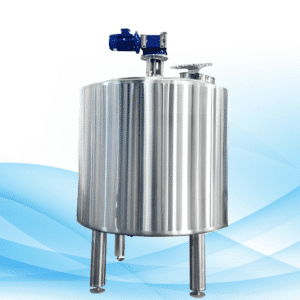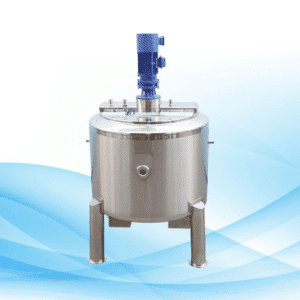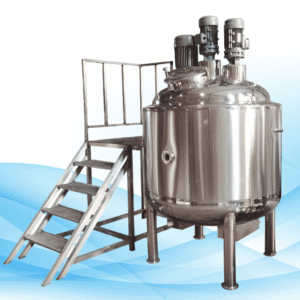What is a Mixing Tank?
A mixing tank can be defined as an industrial tank element which mix, emulsify, homogenize or fuse two or more fluids, solids or even gases. The tanks have a range of application in different industries including the pharmaceutical, chemical and food and beverage industries and assist in maintaining the quality and consistency of the end products. Different types of materials and process parameters are used to combine the materials in these tanks by means of blades or agitators.

Key Components of a Mixing Tank
Tank Body
It is the main member, but it can be modified into different shapes. Sometimes it is simply a hollow cylinder which serves as the container for the ingredients.
Agitator
A Tangential blade or stir stick located within the unit assembly that rotates or mixes the mixture.
Motor
Motor is the most essential part because it is the one responsible for rotating the agitator rotating at a predetermined rotational speed.
Baffles
Extensions of a rod or plate in the tank used to improve mixing hotspots by changing the pattern of flow inside the tank.
Inlets/Outlets
Transfer lines used to dump the raw ingredients and transfer the substrate.
Types of Mixing Tanks
Stainless Steel Mixing Tanks

Stainless steel mixing tanks are very much preferred in the industry because they are durable, non-corrosive and will not allow microbial infection due to the low surface porosity. It is common for this equipment to be used in an industry like a pharmaceutical, and in food production companies, where cleanliness is of topmost importance.
Plastic Mixing Tanks
Plastic tanks are cost-effective and clinical in using light-duty mixing or for non-corrosive materials. These tanks are generally constructed of polyethylene or polypropylene materials, which make them suitable for water treatment and chemical storage.
Industrial Mixing Tanks

Industrial mixing tanks are built for heavy-duty tasks, such as for chemicals, mining or energy, or other sectors requiring more resilience. High Pressure and temperature resistant, these tanks are often lined or made of special materials that have been configured for extreme conditions.
How Do Mixing Tanks Work?
Mixing tanks incorporate mechanical agitation to combine materials as efficiently as possible. Centrally located, or off center, though these agitators, which spin at various speeds, mix the components efficiently. The viscosity of the liquids being mixed, the tank size, and the type of the mixing blade used are some of the significant parameters controlling the mixing process.
Applications of Mixing Tanks
Mixing Tanks in Chemical Industry
In the chemical industry, for example, mixing tanks are employed for the bulk of chemicals, suspensions, and reagents. Based on their design, safety to use tank mixing equipment for chemicals, which are hazardous or volatile, would be reasonable since the tank would ensure safe mixing on target concentrations.
Mixing Tanks in Food and Beverage Industry
From sauces, dressings, and dairy, food and beverage manufacturers employ the tanks for mixing. A necessary feature in this area is being able to achieve uniform properties, flavors, and physical stability of the final product.
Mixing Tanks in Pharmaceuticals
In pharmaceutical industry, mixing tanks are used for the preparation of active drugs mixed with excipients into one uniform consistency. However, most of these tanks are made to order so they can respond to the rigid conservative regulations of both the minor and major markets and most importantly ensure a clean environment while at the same time limiting chances of cross contamination.
Benefits of Using a High Quality Mixing Tank
Increased Efficiency
A well constructed mixing tank warrants reduced mixing duration and better homogeneity of the end product.
Reduced Costs
High-quality tanks need less maintenance and have lower downtime, hence translating to cost benefits in the long run.
Uniformity
The use of mixing tanks helps to maintain uniformity in quality of the end products, and this is especially important in food processing and pharmaceutical industries.
Factors to Consider When Buying a Mixing Tank
Tank Size and Volume
This is important in making sure that the tank that is being chosen is large enough to accommodate the desired amount of material without spilling any or not mixing the material effectively. Capacities vary from small lab types to large industrial types.
Materials and Durability
The tank must be constructed from stainless steel or plastic as appropriate according to the types of the mixtures that will be done in the tank. For example, there will be a need for a tank made from a very hard material for the corrosive chemicals.
Agitators and Blades
The mixing efficiency of the components is affected by the type of the agitator and how the blades are designed. High-shear blades are good for emulsifying, but for the more delicate blending contraction paddle blades are better suited.
How to Maintain and Clean a Mixing Tank
It is fundamental to clean the mixing tanks properly and also maintain them properly so that the tanks can last long and minimize cases of contamination. The outer look of the tank body and the interior parts like the agitators and the seals should be checked at intervals. The method of cleaning the tank involves various methods depending on the mixing material, but most of the systems apply cleaning-in-place (CIP) as is for the case in the food and pharmaceutical industries which are considered to be hygienic industries.
Custom Mixing Tanks: Tailored Solutions for Your Industry
Most suppliers provide custom mixing tanks appropriate for a particular industry or activity. Businesses can maximize the use of the tank for different types of mixing processes, such as mixing at elevated temperature or corrosive mixing.
Common Problems with Mixing Tanks and How to Solve Them
Inconsistent Mixing
This could be due to improper agitator speed or blade design. Normally this can be remedied by changing the agitation parameters.
Tank Integrity and Leakage
The problem can be avoided by performing regular inspections and doing repairs on the seals on time.
Clogging
It is important to note that raw materials which have not been prepared properly before being thrown into the tank can cause clogs.
How to Optimize the Performance of Mixing Tanks
To achieve the best results, the thickness of the mixture along with the speed of mixing, the design of the mixing blades and the orientation of the baffles should be adjusted appropriately. It is additionally consequence of the performance of the tank to perform routine maintenance works, such as cleaning of the agitating instruments and checking that all the seals have not been tampered with.
Tank Mixing Safety: Guidelines and Precautions to Take
Proper Ventilation
When handling any volatile material, ensure that there is good ventilation around the tank area.
Emergency Shut-offs
Implementation of emergency stopping devices is crucial as it prevents occurrence of accidents due to malfunctioning of the agitator.
Regular Inspections
Implement regularly due safety assessment of the tank, the motor’s performance and the performance of the agitator.
What Does The Future Hold for Mixing Tank Technology?
In recent times, the growing trend seems to focus on improvements to the mixing tank design in order to include smart sensors which monitor activity in real time. Great improvements that will enhance energy efficiency coupled with automation is what to expect in the future.
Frequently Asked Questions About Mixing Tanks
What materials are used in mixing tanks?
Depending on the application and the nature of the substances being mixed, mixing tanks can be made from stainless steel, plastic (polyethylene, polypropylene) or alloys.
How do you clean a mixing tank properly?
Harsh scrubbing or the use of automated systems such as CIP (clean-in-place) can also wash out some mixing tanks as the cleaning material circulates about the tank instead of disassembling the tank.
What industries commonly use mixing tanks?
Mixing tanks find applications in a good number of industries including the pharmaceutical, food and beverage, chemicals, cosmetics industry, and even in waste water treatment.
How long does a typical mixing tank last?
Depending on the material, maintenance and usage, There are China mixing tanks which are made of stainless steel which can last for several decades if well maintained. Plastic tanks on the other hand might have shorter life span.
Can mixing tanks be customized?
Yes, most of the mixing tank manufacturers claim that they have a custom mixing tank for their customers that is designed to different specifications, for example, size, type of material or presence of agitators.
What Factors Come to Play When It Comes to the Price Of A Mixing Tank?
A mixing tank may be expensive as there are several determinants that include the mixing tank’s size, the raw materials used in construction, the intricacy of the design, and the availability or want for smart sensors and heating elements.
Conclusion: The Importance of Choosing the Right Mixing Tank
Choosing the proper mixing tank is essential in order to achieve the desired level of operational efficiency and product quality.









